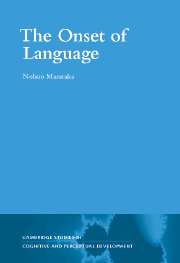Book contents
- Frontmatter
- Contents
- List of figures
- List of tables
- Acknowledgements
- 1 Introduction
- 2 The development of the ability to take turns
- 3 Cooing in three-month-old infants
- 4 The development of vocal imitation
- 5 How infant-directed speech influences infant vocal development
- 6 From laughter to babbling
- 7 Earliest language development in sign language
- 8 From babbling to speaking
- 9 Summary and conclusion
- References
- Index
7 - Earliest language development in sign language
Published online by Cambridge University Press: 15 January 2010
- Frontmatter
- Contents
- List of figures
- List of tables
- Acknowledgements
- 1 Introduction
- 2 The development of the ability to take turns
- 3 Cooing in three-month-old infants
- 4 The development of vocal imitation
- 5 How infant-directed speech influences infant vocal development
- 6 From laughter to babbling
- 7 Earliest language development in sign language
- 8 From babbling to speaking
- 9 Summary and conclusion
- References
- Index
Summary
This chapter is devoted to identifying the signed equivalents of hearing preverbal infant–caregiver interactions in deaf infant–caregiver interactions and to overviewing this latter developmental process, which appears to play an important role in language acquisition of deaf infants. Thus far, studies have examined early parent–infant interaction from a variety of perspectives. However, virtually all of them have focused on hearing infants while very little attention has been focused on deaf infants. What can the study of early sign language acquisition tell us about the human capacity for language? Linguists have not hesitated to propose theories of human language based on data drawn only from spoken language. Several theories of very early language development are based on the hypothesis that infants' emerging linguistic abilities are determined by the mechanisms underlying the production and perception of speech and/or the mechanisms of general perception. Given that most studies focus only on spoken language, it is in principle impossible to find data that would do anything but support this hypothesis. Only by examining language in another modality would it be possible to determine fully the relative contributions of motor production and perception constraints to the time course and nature of early human language acquisition. By considering all natural human language, both signed and spoken, we can gain a better understanding of the essential prerequisites for language acquisition, how language evolved, and how its use is conditioned by natural limitations on the organs of articulation and the sensory mechanisms for perception.
- Type
- Chapter
- Information
- The Onset of Language , pp. 188 - 216Publisher: Cambridge University PressPrint publication year: 2003

